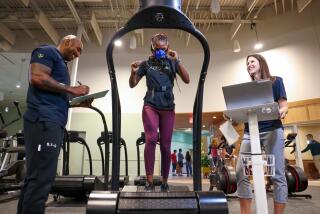It’s Virtually Like Having a Personal Trainer
- Share via
Mark Zurmuhlen is devoted to fitness. But, boy, he hates going to the gym.
“Too expensive and too cold,” he says.
He likes the idea of having a personal trainer to help him keep track of his progress. But personal trainers are, well, “expensive.”
All Zurmuhlen--a 40-year-old resident of Washington, D.C.--wants is to work out in the privacy of his home with a little assistance and at a modest price.
Enter, online Xavier Carrica. Carrica, a Los Angeles-based personal trainer who is well-known in celebrity fitness circles, has teamed with Stargate Multimedia Ltd. to launch what they say is the most advanced take yet on a “virtual gym.”
The site, called Fitsource (https://www.fitsource.com), allows Carrica to serve as a personal trainer by communicating with his clients via the Internet. Carrica, who majored in business in college, is also a computer buff who saw the technology as a way to reach more clients.
“There are a lot of people who can’t afford a personal trainer. But this is something they can afford,” he says.
For $29.88 a month, Carrica will give each client a weekly fitness plan that includes exercises and meals. He e-mails his clients about three times a week to offer encouragement or answer questions. At the end of the week, clients send back a summary of their progress and Carrica tailors another plan for them by Monday.
Clients can also download video clips that demonstrate Carrica doing the exercises he prescribes. And there are links to other fitness companies at which clients can purchase fitness goods and tap into other resources.
“The point is to give our clients the whole fitness experience,” says Steven C. Smith of Stargate Multimedia, a Hollywood-based Internet / intranet development and design firm, which developed the site.
The concept is designed to help people who hate going to the gym but who need to draw on some form of personal interaction to work out at home, he says.
“With a TV fitness show, you don’t get personal interaction,” Smith says. “Fitsource allows Xavier to encourage people who may be too shy to go to the gym.”
Carrica says the majority of his 30-some clients so far are men in their 20s or 30s who are struggling with their weight and prefer to work out at home.
The personal-trainer part of Fitsource was just launched although Carrica established a Web page about a year ago that anyone can tap into. The Web site features a question-and-answer column on fitness and information on how to subscribe to the personal trainer part of the site.
Jeff Mainville, 36, of San Francisco says Fitsource is just what he was looking for.
“I’ve been a little out of shape, and I was surfing the Web for fitness sites. I liked Fitsource. It was simple, and there wasn’t a lot of fluff,” Mainville says.
Like every member, Mainville filled out an extensive questionnaire about his health, fitness habits, goals and available equipment before Carrica prescribed his personal plan. Mainville says he’s seeing results.
“I feel I’m getting personal attention. I have my own little site at the gym. It’s not total seclusion. Xavier is very responsive,” he says.
While there are other fitness Web sites, Smith and Carrica say no one is using an Internet fitness program with as much interaction.
Nevertheless, because the interaction between Carrica and his clients is not yet live, Carrica’s dream of running a “virtual” gym is a ways off. Someday soon, a technology known as “video streaming” should be available so clients can log on and watch Carrica’s classes as he’s conducting them in the gym.
“When Xavier first presented his idea of a virtual gym to us, I knew it was possible, but I wondered if it was too early in the game,” says Smith of the technological limitations of the Internet. “Delivering audio and video over the Internet is still a painfully slow process. Most people don’t have high-speed technology at home.”
For example, he says, if it takes too long to download Carrica’s video clips, clients can ask for the information on CD-ROM. Eventually, Smith says, the advent of cable-operated modems will speed up transmission of audio and video material.
Carrica says he won’t be satisfied until his gym is virtual.
“It’s still a bit impersonal, which is why I can’t wait for video streaming. But this is teaching me a new way of communicating,” he says.
As the technology becomes available, Stargate and Carrica hope to build a gym from which they can transmit fitness classes live. Other fitness instructors may eventually be hired. They have already invested about $35,000 in the venture and hope to eventually sign up 8,000 members.
“I think we’re still a year away from video streaming. But the whole idea of the site is that, when the time comes, we’ll be ready,” Smith says.
More to Read
Inside the business of entertainment
The Wide Shot brings you news, analysis and insights on everything from streaming wars to production — and what it all means for the future.
You may occasionally receive promotional content from the Los Angeles Times.










